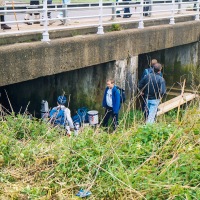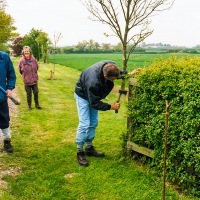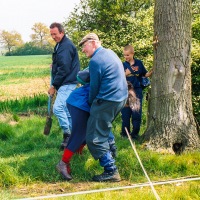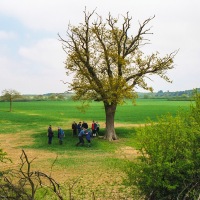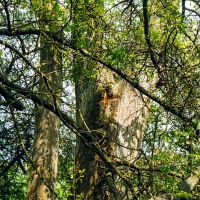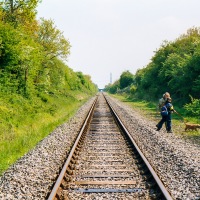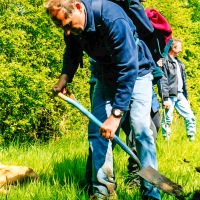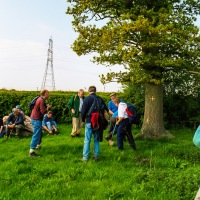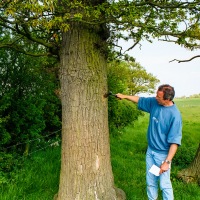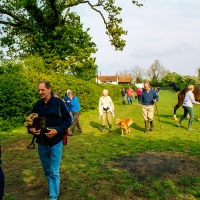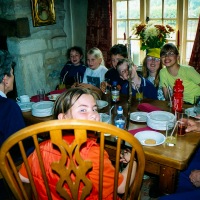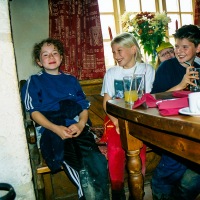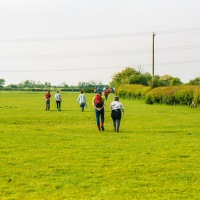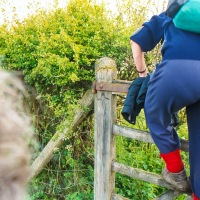Beating The Bounds, Grendon Underwood, 8th May 2002

Few among us can pretend to know the precise location of the parish boundary that surrounds us. One way of finding out is to consult an ordnance survey map, but a much more enjoyable method is to take part in the ‘The Beating of Bounds’ due to take place on Wednesday 8th May 2002. Miss this chance and you will not have another opportunity until 2009.
Before 1820 our ancestors had no easily available accurate maps, so parish limits were marked and memorised during regular, often annual, perambulations. Most country customs have their origins in the distant past, and the beating of the parish bounds at Rogation-tide is no exception. The Latin word ‘rogare’ (to beseech) gives the name Rogation to the days immediately before The Feast of Ascension, which is when the perambulations of the parish traditionally took place. Historical sources tell us that the Anglo-Saxons were familiar with the ritual, but man’s habit of protecting what he holds, and being prepared to assert the right of occupation too, probably means that the custom, in some form, pre-dates our Saxon cousins.
Ancient parishes, at least in the form we know them today, did come into being in the Anglo-Saxon period, replacing the ancient land division of hundreds. We can read in accounts of life in Saxon times that, by tradition, a group of parishioners accompanied by the parish priest made a perambulation of the parish bounds and also said prayers beseeching God’s blessing on the growing crops at Rogation-tide. The sign of the Christian cross was cut at certain places, both in the turf and on convenient trees or posts. At other significant points, young boys were ‘bumped’ with a spade so as to remember important locations along the boundary. Fields then were not enclosed by hedges, so boundary marking was not as easy as it is today. Their processions were grand affairs, for, by all accounts, the local rates ‘would pay expenses properly incurred, but would not pay for music, banners and unnecessary adjuncts’.
In Grendon Underwood, as in many other rural parishes, the custom of regular perambulation had died out but was resumed in 1946. In 1952 the date was changed to coincide with Waddesdon, and every seven years since then St Leonards’ parish boundaries have been successfully negotiated, including 1966 when the wet weather made conditions difficult. Waddesdon postponed their perambulation in that year; probably a wise decision as the river Thame was in late flood. When the custom was revived in Grendon Underwood, only a handful of souls initially took part, but in recent years the turnout has improved, often bolstered by the children of Grendon Underwood Combined School.
THE RECENT YEARS
In 1981, the final part of the route was impassable due to flooding, but 23 people went as far as possible, 12 of these completed the course a week later. 48 people took part in 1988, with 17 completing the circuit. More than twice that number, 40 completed the perambulation of 1995, and 10 walked part of the way.
THE ROUTE
The perambulation of the Grendon Underwood parish begins at Gallows Bridge, at the southern end of the Broadway, reputedly once the site of the local gallows. The route initially follows the course of the A41, an ancient thoroughfare known by the Romans as Akeman Street, or ‘road of the invalids’, because it connected London to Bath, (Akemancester) and it’s curative spa waters.
This part of the trek cannot be described as pleasant, going as it does alongside the juggernaut laden A41, but the trunk road is soon left behind, as we turn right to find ‘the three points’. Three streams converge here to form the River Ray. Some of the water meadows hereabouts have been acquired recently by the Berks, Bucks and Oxon Naturalist Trust, as a prime wetland nature-reserve. The river is beside us for a mile or so, and after leaving it we cross the Grendon to Marsh Gibbon Road and not long after, the road linking Grendon with Edgcott.,
Lawn House is the next landmark on our journey, after which we skirt the walls of Her Majesty’s Prison at Grendon Hall. The site of the prison here has probably given Grendon Underwood unwanted notoriety, although this is a matter of conjecture, We then head across the fields to Prune Farm where we take a welcome refreshment break.
The next part of our journey takes us over the road linking Edgcott and Quainton, and after a while, we encounter two man-made features that dominate this section of our journey. First, we pass close by the eastern end of the Calvert landfill site, where we may mourn the loss of the familiar tall chimneys that once towered imperiously over the famous Calvert brickworks. Then we cross the railway for the first time at Greatmoor, but more about the iron road later.
If we split our tour into three parts, the second part is associated with the wooded areas of the parish. We soon reach Sheephouse wood, then Romer wood, although we do no more than skirt their perimeters. They need not concern us though, as they belong to the neighbouring parishes of Charndon and Middle Claydon respectively Newcomers to the bound beating may already be wondering if there is either rhyme or reason for the meandering of the boundary. But there is more deviation to come, for at this point Grendon Parish sticks out an arm to embrace the summit of Finemere Hill. The hilltop provides an ideal spot for lunch, and from here we can survey the whole of our parish stretched out below us.
Finemere Wood, nearby our picnic spot, and on our left flank as we head downhill after our victuals is another thriving nature reserve managed by BBONT. At the foot of the hill, we re-cross the railway line at Grendon Underwood Junction. The junction of the rails is only a few feet within our parish. It is hard to believe that this quiet spot was once a busy intersection on The Great Central route from London Marylebone to Sheffield and Manchester. The only trains that now use the line bring North London’s waste for internment at Calvert.
Onward then, to pass through tiny Hewin’s wood, before re-crossing the road between Edgcott and Quainton and entering another woodland area; namely Lee, Grendon and Doddershall woods. These three woods, that are nowadays almost merged into one, contain several well-manicured rides. It would be too much to hope that any of them coincided with our desired course. One or two stalwarts usually follow the true route here, while the rest use a more forgiving path, or search for the ‘King Tree’, said to be the loftiest of the many high trees within Doddershall wood.
A field or two beyond Doddershall wood we join Lee Turn road, just below Oving Hill Farm. The boundary line roughly follows the lane almost as far as the Kingswood to Grendon Road, and while in this vicinity we usually meet our Waddesdon counterparts on the orbit of their parish. We may be weary, but spare a thought for them; this is their second day on the march: their bounds are twice as long as ours.
Before Grendon Road is reached we turn left onto a bridle-way; Ham Home wood is on our right, but we soon pass along an avenue between it and it’s close companion, Ham Green wood, to arrive once more at the A41 near The Crooked Billet. It is not an easy thing to pass an inn when in the first throes of exhaustion, but our thirst will soon be slaked as the parish perimeter passes directly through the Plough & Anchor. This is too good an opportunity to miss, and we stop here for a cup of tea: or something stronger. Afternoon Tea is provided by the Parish Council.
Half an hour’s inactivity near the end of our hike makes the final leg a little tiresome. If logic were our guide, the journey to Gallows Bridge would follow the main road, but not so. We have seen earlier in the day that a parish can reach out to surround a coveted spot, and this time it is Ludgershall Parish that has deftly stolen both Sharp’s Hill and the farm of the same name. So our route leaves the highway to follow the northern lea of Sharp’s Hill. There is a good view from here of the water meadows traversed earlier in the day, and an opportunity too to see Grendon Underwood’s southern aspect. Not a pretty village, but handsome enough when viewed from a distance, It’s all downhill from here to our starting point at Gallows Bridge. The boundary, however, has one more surprise in store, as it crosses to the south side of Akeman Street not far from the finish. To say you have truly ‘beaten the bounds’ you must cross a tributary of the Ray, on a pipe that passes precariously over the stream beneath.
WHAT YOU’LL NEED ON THE DAY
If you’d like to join us on May 8th you will be most welcome, you do not have to walk the full circuit.
All those taking part will receive a certificate confirming their participation. You will need suitable footwear and a packed lunch. Helpers on the day will ferry items to various points on the route, including the lunch stop at Finemere Hill. There will be field parking near Gallows Bridge.
BEATING THE BOUNDS
What ancient ritual this, that bids us stalk the orbit of our church?
Mark down the Christian sign upon the sod:
Score too the cross upon the stately oak, the sycamore and birch.
But, all in all, how strange this custom seems;
Did the early boundary markers ever know our god?
Just a line upon a simple rural chart, or local rhyme,
Shows us the way to go, and then to fashion new,
The sundry ways and paths laid down by nothing more than time.
Remember well the circuit that we take,
For future folk may hope to find a guide in you.
No towering mountain here, just Finemere Hill,
No great meandering river; only the quiet-watered Ray,
How many oceans did this little river fill?
We roam green lanes amid the calming meadowland.
Do not let progress take this leafy country charm away.
Where have they gone, those seven long years,
Since we last roundly wandered hereabout?
The path, once vivid, grows vague, then disappears.
Call back along the file, the stalwarts always know the way.
The map within their mind leaves little room for doubt.
And so with axe and spade we venture on,
A motley and a cheery company, but with a lordly goal,
Pursuing ghosts that walked this way in times long gone.
A chance to find the restive native past,
To become again, part of the simple village soul.
This little parish then is neatly tucked away within its bounds.
And our small happy task is once more done: just in a day.
By woodland and by glebe we’ve traced parochial grounds.
St Leonards Church may stand another thousand years.
But which of us few friends shall pass again this way?
Contributed by Chris Giblin
THE ACTUAL DAY
The weather could not have been much better for the walk. It did start out cold and a little grey, but soon we saw the sun. It was ideal walking weather, not cold and not hot. We had three stops on the way. Coffee was provided for us at Prune farm. We ate our picnic lunchs at the highest point of the walk, Finemerehill. Tea and sandwiches washed down with beer at The Plough and Anchor. The walk finished at around 6.30.
THE FOLLOWING COMPLETED THE PERAMBULATION (61)
Ray Goss, Elisabeth Mason, Andrew Benfield, Bob Smith, Judy Smith, Sally Abell
Jean Crawford, Hector Crawford, Richard Smith
Angela Shenstone, Pat Brazier, Venetia Hugh Smith
Chris Giblin snr, Norma Gassor, Chris Giblin jnr
Andy Cruickshank, Diana Lacey, Roger Lacey
Barrie Johnson, Barbara Johnson, Steve Plowman
Barry Houghton, Pat Houghton, Suzan Jones
Steve Blasdale, Rosemary Blasdale, Jenny Hyndman
Peter Hornigold, Julia Hornigold, Brian Portergill
Ian Brindle, Pat Brindle, Sue Hall
John Law, Debbie Chandler, Alan Austin
Gerald Tincello, Jessel Tincello, Alan Roberts
David Sanderson, Barbara Sanderson, Maggie Campbell Keith
Peter Young, Mark Young, Tony Young
Tim Heaton, Sheila Martindale, Roxanne Cooper
Chris Beckerlegg, David Barnett, Imogen Yapp
Flora Lewis, Leo Brooks, Rachel Card
Ryan Nolan, Magenta Eele, Lauren Cyster
Beverley Hall, Scott Drake, Tom Swetman, Paul Cooper
Plus our four legged friends, Corrie, Widgeon, Copper, Cello, Nell, Nora, Nina & Woody.
THE FOLLOWING DID PART OF THE PERAMBULATION (4)
Andrew Hugh Smith, Margaret Golby, Steve Chandler and Ann Prosser
THE SUPPORT CREW (1)
Alan Golby
OUR HOSTS FOR MORNING COFFEE AT PRUNE FARM
Louise & Alan Gaunt
.
OUR HOSTS FOR AFTERNOON TEA AT THE PLOUGH & ANCHOR
(Provided by the Parish Council)
Ricky Chan & Paul Ring
VIPS
Also present at the Start: Chloe Lambert, Chairman of AVDC, & John Cartwright AVDC.

